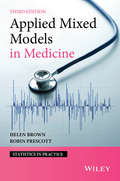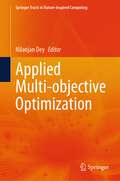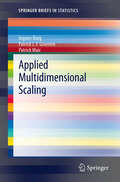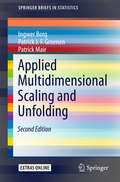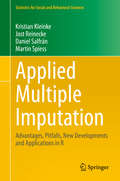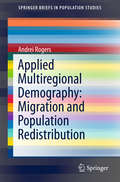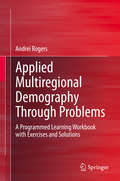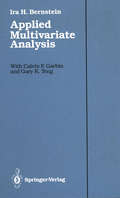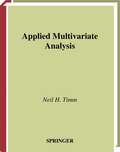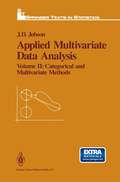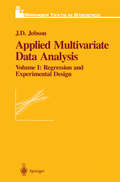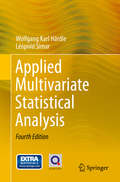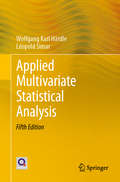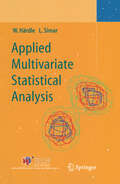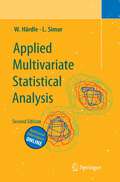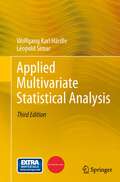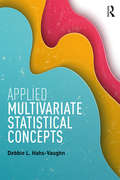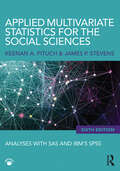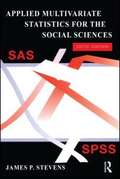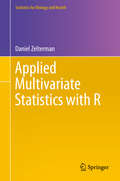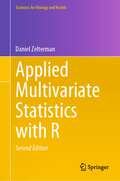- Table View
- List View
Applied Mixed Models in Medicine (Statistics in Practice #28)
by Helen Brown Robin PrescottA fully updated edition of this key text on mixed models, focusing on applications in medical research The application of mixed models is an increasingly popular way of analysing medical data, particularly in the pharmaceutical industry. A mixed model allows the incorporation of both fixed and random variables within a statistical analysis, enabling efficient inferences and more information to be gained from the data. There have been many recent advances in mixed modelling, particularly regarding the software and applications. This third edition of Brown and Prescott’s groundbreaking text provides an update on the latest developments, and includes guidance on the use of current SAS techniques across a wide range of applications. Presents an overview of the theory and applications of mixed models in medical research, including the latest developments and new sections on incomplete block designs and the analysis of bilateral data. Easily accessible to practitioners in any area where mixed models are used, including medical statisticians and economists. Includes numerous examples using real data from medical and health research, and epidemiology, illustrated with SAS code and output. Features the new version of SAS, including new graphics for model diagnostics and the procedure PROC MCMC. Supported by a website featuring computer code, data sets, and further material. This third edition will appeal to applied statisticians working in medical research and the pharmaceutical industry, as well as teachers and students of statistics courses in mixed models. The book will also be of great value to a broad range of scientists, particularly those working in the medical and pharmaceutical areas.
Applied Mixed Models in Medicine (Statistics in Practice)
by Helen Brown Robin PrescottA fully updated edition of this key text on mixed models, focusing on applications in medical research The application of mixed models is an increasingly popular way of analysing medical data, particularly in the pharmaceutical industry. A mixed model allows the incorporation of both fixed and random variables within a statistical analysis, enabling efficient inferences and more information to be gained from the data. There have been many recent advances in mixed modelling, particularly regarding the software and applications. This third edition of Brown and Prescott’s groundbreaking text provides an update on the latest developments, and includes guidance on the use of current SAS techniques across a wide range of applications. Presents an overview of the theory and applications of mixed models in medical research, including the latest developments and new sections on incomplete block designs and the analysis of bilateral data. Easily accessible to practitioners in any area where mixed models are used, including medical statisticians and economists. Includes numerous examples using real data from medical and health research, and epidemiology, illustrated with SAS code and output. Features the new version of SAS, including new graphics for model diagnostics and the procedure PROC MCMC. Supported by a website featuring computer code, data sets, and further material. This third edition will appeal to applied statisticians working in medical research and the pharmaceutical industry, as well as teachers and students of statistics courses in mixed models. The book will also be of great value to a broad range of scientists, particularly those working in the medical and pharmaceutical areas.
Applied Multi-objective Optimization (Springer Tracts in Nature-Inspired Computing)
by Nilanjan DeyThe book explains basic ideas behind several kinds of applied multi-objective optimization and shows how it will be applied in practical contexts in the domain of healthcare, engineering design, and manufacturing. The book discusses how meta-heuristic algorithms are successful in resolving challenging, multi-objective optimization issues in various disciplines, including engineering, economics, medical and environmental management. The topic is useful for graduates, researchers and lecturers in optimization, engineering, management science and computer science.
Applied Multidimensional Scaling (SpringerBriefs in Statistics)
by Ingwer Borg Patrick JF Groenen Patrick MairThis book introduces MDS as a psychological model and as a data analysis technique for the applied researcher. It also discusses, in detail, how to use two MDS programs, Proxscal (a module of SPSS) and Smacof (an R-package). The book is unique in its orientation on the applied researcher, whose primary interest is in using MDS as a tool to build substantive theories. This is done by emphasizing practical issues (such as evaluating model fit), by presenting ways to enforce theoretical expectations on the MDS solution, and by discussing typical mistakes that MDS users tend to make. The primary audience of this book are psychologists, social scientists, and market researchers. No particular background knowledge is required, beyond a basic knowledge of statistics.
Applied Multidimensional Scaling and Unfolding (SpringerBriefs in Statistics)
by Ingwer Borg Patrick J.F. Groenen Patrick MairThis book introduces multidimensional scaling (MDS) and unfolding as data analysis techniques for applied researchers. MDS is used for the analysis of proximity data on a set of objects, representing the data as distances between points in a geometric space (usually of two dimensions). Unfolding is a related method that maps preference data (typically evaluative ratings of different persons on a set of objects) as distances between two sets of points (representing the persons and the objects, resp.).This second edition has been completely revised to reflect new developments and the coverage of unfolding has also been substantially expanded. Intended for applied researchers whose main interests are in using these methods as tools for building substantive theories, it discusses numerous applications (classical and recent), highlights practical issues (such as evaluating model fit), presents ways to enforce theoretical expectations for the scaling solutions, and addresses the typical mistakes that MDS/unfolding users tend to make. Further, it shows how MDS and unfolding can be used in practical research work, primarily by using the smacof package in the R environment but also Proxscal in SPSS. It is a valuable resource for psychologists, social scientists, and market researchers, with a basic understanding of multivariate statistics (such as multiple regression and factor analysis).
Applied Multiple Imputation: Advantages, Pitfalls, New Developments and Applications in R (Statistics for Social and Behavioral Sciences)
by Kristian Kleinke Jost Reinecke Daniel Salfrán Martin SpiessThis book explores missing data techniques and provides a detailed and easy-to-read introduction to multiple imputation, covering the theoretical aspects of the topic and offering hands-on help with the implementation. It discusses the pros and cons of various techniques and concepts, including multiple imputation quality diagnostics, an important topic for practitioners. It also presents current research and new, practically relevant developments in the field, and demonstrates the use of recent multiple imputation techniques designed for situations where distributional assumptions of the classical multiple imputation solutions are violated. In addition, the book features numerous practical tutorials for widely used R software packages to generate multiple imputations (norm, pan and mice). The provided R code and data sets allow readers to reproduce all the examples and enhance their understanding of the procedures. This book is intended for social and health scientists and other quantitative researchers who analyze incompletely observed data sets, as well as master’s and PhD students with a sound basic knowledge of statistics.
Applied Multiregional Demography: Migration and Population Redistribution (SpringerBriefs in Population Studies #0)
by Andrei RogersThis book shows the effectiveness of multiregional demography for studying the spatial dynamics of migration and population redistribution. It examines important questions in demographic analysis and shows how the techniques of multiregional analysis can lead to answers that sometimes contradict conventional wisdom. The book reconsiders conclusions reached in the literature regarding several fundamental common sense demographic questions in migration and population redistribution, including: Is it mostly migration or “aging-in-place” that has been driving Florida’s elderly population growth? Do the elderly return “home” after retirement more than the non-elderly do? Does longer life lead to longer ill-health? Do simple population projection models outperform complex ones? For each demographic question it reconsiders, the book begins with a simple empirical numerical example and with it illustrates how a uniregional specification can bias findings to favor a particular, and possibly incorrect, conclusion. It then goes on to show how a multiregional analysis can better illuminate the dynamics that underlie the observed population totals and lead to a more informed conclusion. Offering insights into the effectiveness of multiregional demography, this book serves as a valuable resource for students and researchers searching for a better way to answer questions in demographic analysis and population dynamics.
Applied Multiregional Demography Through Problems: A Programmed Learning Workbook with Exercises and Solutions
by Andrei RogersWritten by the 2018 Mindel C. Sheps Award winner, this textbook offers a unique method for teaching how to model spatial (multiregional) population dynamics through models of increasing complexity. Each chapter in this programmed workbook starts with a descriptive text, followed by a sequence of exercises focused on particular multiregional models, of increasing complexity, and then ends with the solutions.It extends the current developments in the spatial analysis of social data towards improving our understanding of dynamics and interacting change across multiple populations in space. Frameworks for analyzing such dynamics were first proposed in multiregional demography, over 40 years ago. This book revisits these methods and then illustrates how they may be used to analyze spatial data and study spatial population dynamics.Topics covered include spatial population dynamics, population projections and estimations, spatial and age structure of migration flows and much more. As such this innovative textbook is a great teaching and learning tool for teachers, students as well as individuals who want to study demographic processes across space.
Applied Multivariate Analysis
by Ira H. BernsteinLike most academic authors, my views are a joint product of my teaching and my research. Needless to say, my views reflect the biases that I have acquired. One way to articulate the rationale (and limitations) of my biases is through the preface of a truly great text of a previous era, Cooley and Lohnes (1971, p. v). They draw a distinction between mathematical statisticians whose intel lect gave birth to the field of multivariate analysis, such as Hotelling, Bartlett, and Wilks, and those who chose to "concentrate much of their attention on methods of analyzing data in the sciences and of interpreting the results of statistical analysis . . . . (and) . . . who are more interested in the sciences than in mathematics, among other characteristics. " I find the distinction between individuals who are temperamentally "mathe maticians" (whom philosophy students might call "Platonists") and "scientists" ("Aristotelians") useful as long as it is not pushed to the point where one assumes "mathematicians" completely disdain data and "scientists" are never interested in contributing to the mathematical foundations of their discipline. I certainly feel more comfortable attempting to contribute in the "scientist" rather than the "mathematician" role. As a consequence, this book is primarily written for individuals concerned with data analysis. However, as noted in Chapter 1, true expertise demands familiarity with both traditions.
Applied Multivariate Analysis (Springer Texts in Statistics)
by Neil H. TimmThis book provides a broad overview of the basic theory and methods of applied multivariate analysis. The presentation integrates both theory and practice including both the analysis of formal linear multivariate models and exploratory data analysis techniques. Each chapter contains the development of basic theoretical results with numerous applications illustrated using examples from the social and behavioral sciences, and other disciplines. All examples are analyzed using SAS for Windows Version 8.0.
Applied Multivariate Data Analysis: Volume II: Categorical and Multivariate Methods (Springer Texts in Statistics)
by J.D. JobsonA Second Course in Statistics The past decade has seen a tremendous increase in the use of statistical data analysis and in the availability of both computers and statistical software. Business and government professionals, as well as academic researchers, are now regularly employing techniques that go far beyond the standard two-semester, introductory course in statistics. Even though for this group of users shorl courses in various specialized topics are often available, there is a need to improve the statistics training of future users of statistics while they are still at colleges and universities. In addition, there is a need for a survey reference text for the many practitioners who cannot obtain specialized courses. With the exception of the statistics major, most university students do not have sufficient time in their programs to enroll in a variety of specialized one-semester courses, such as data analysis, linear models, experimental de sign, multivariate methods, contingency tables, logistic regression, and so on. There is a need for a second survey course that covers a wide variety of these techniques in an integrated fashion. It is also important that this sec ond course combine an overview of theory with an opportunity to practice, including the use of statistical software and the interpretation of results obtained from real däta.
Applied Multivariate Data Analysis: Regression and Experimental Design (Springer Texts in Statistics)
by J.D. JobsonAn easy to read survey of data analysis, linear regression models and analysis of variance. The extensive development of the linear model includes the use of the linear model approach to analysis of variance provides a strong link to statistical software packages, and is complemented by a thorough overview of theory. It is assumed that the reader has the background equivalent to an introductory book in statistical inference. Can be read easily by those who have had brief exposure to calculus and linear algebra. Intended for first year graduate students in business, social and the biological sciences. Provides the student with the necessary statistics background for a course in research methodology. In addition, undergraduate statistics majors will find this text useful as a survey of linear models and their applications.
Applied Multivariate Statistical Analysis
by Wolfgang Karl Härdle Léopold SimarFocusing on high-dimensional applications, this 4th edition presents the tools and concepts used in multivariate data analysis in a style that is also accessible for non-mathematicians and practitioners. All chapters include practical exercises that highlight applications in different multivariate data analysis fields. All of the examples involve high to ultra-high dimensions and represent a number of major fields in big data analysis.The fourth edition of this book on Applied Multivariate Statistical Analysis offers the following new features:A new chapter on Variable Selection (Lasso, SCAD and Elastic Net)All exercises are supplemented by R and MATLAB code that can be found on www.quantlet.de.The practical exercises include solutions that can be found in Härdle, W. and Hlavka, Z., Multivariate Statistics: Exercises and Solutions. Springer Verlag, Heidelberg.
Applied Multivariate Statistical Analysis
by Wolfgang Karl Härdle Léopold SimarThis textbook presents the tools and concepts used in multivariate data analysis in a style accessible for non-mathematicians and practitioners. All chapters include practical exercises that highlight applications in different multivariate data analysis fields, and all the examples involve high to ultra-high dimensions and represent a number of major fields in big data analysis.For this new edition, the book has been updated and extensively revised and now includes an extended chapter on cluster analysis. All solutions to the exercises are supplemented by R and MATLAB or SAS computer code and can be downloaded from the Quantlet platform. Practical exercises from this book and their solutions can also be found in the accompanying Springer book by W.K. Härdle and Z. Hlávka: Multivariate Statistics - Exercises and Solutions.The Quantlet platform, quantlet.de, quantlet.com, quantlet.org, is an integrated QuantNet environment consisting of different types of statistics-related documents and program codes. Its goal is to promote reproducibility and offer a platform for sharing validated knowledge native to the social web. QuantNet and the corresponding data-driven document-based visualization allow readers to reproduce the tables, pictures and calculations presented in this Springer book.
Applied Multivariate Statistical Analysis
by Wolfgang Karl Härdle Léopold SimarA state of the art presentation of the tools and concepts of multivariate data analysis with a strong focus on applications. The first part is devoted to graphical techniques describing the distributions of the involved variables. The second part deals with multivariate random variables and presents distributions, estimators and tests for various practical situations. The last part covers mulivariate techniques and introduces the reader into the wide variety of tools for multivariate data analysis. The text presents a wide range of examples and 228 exercises.
Applied Multivariate Statistical Analysis
by Wolfgang Karl Härdle Léopold SimarWith a wealth of examples and exercises, this is a brand new edition of a classic work on multivariate data analysis. A key advantage of the work is its accessibility. This is because, in its focus on applications, the book presents the tools and concepts of multivariate data analysis in a way that is understandable for non-mathematicians and practitioners who need to analyze statistical data. In this second edition a wider scope of methods and applications of multivariate statistical analysis is introduced. All quantlets have been translated into the R and Matlab language and are made available online.
Applied Multivariate Statistical Analysis
by Wolfgang Karl Härdle Léopold SimarMost of the observable phenomena in the empirical sciences are of a multivariate nature. In financial studies, assets are observed simultaneously and their joint development is analysed to better understand general risk and to track indices. In medicine recorded observations of subjects in different locations are the basis of reliable diagnoses and medication. In quantitative marketing consumer preferences are collected in order to construct models of consumer behavior. The underlying data structure of these and many other quantitative studies of applied sciences is multivariate. Focusing on applications this book presents the tools and concepts of multivariate data analysis in a way that is understandable for non-mathematicians and practitioners who need to analyze statistical data. The book surveys the basic principles of multivariate statistical data analysis and emphasizes both exploratory and inferential statistics. All chapters have exercises that highlight applications in different fields.The third edition of this book on Applied Multivariate Statistical Analysis offers the following new featuresA new Chapter on Regression Models has been addedAll numerical examples have been redone, updated and made reproducible in MATLAB or R, see www.quantlet.org for a repository of quantlets.
Applied Multivariate Statistical Concepts
by Debbie L. Hahs-VaughnMore comprehensive than other texts, this new book covers the classic and cutting edge multivariate techniques used in today’s research. Ideal for courses on multivariate statistics/analysis/design, advanced statistics or quantitative techniques taught in psychology, education, sociology, and business, the book also appeals to researchers with no training in multivariate methods. Through clear writing and engaging pedagogy and examples using real data, Hahs-Vaughn walks students through the most used methods to learn why and how to apply each technique. A conceptual approach with a higher than usual text-to-formula ratio helps reader’s master key concepts so they can implement and interpret results generated by today’s sophisticated software. Annotated screenshots from SPSS and other packages are integrated throughout. Designed for course flexibility, after the first 4 chapters, instructors can use chapters in any sequence or combination to fit the needs of their students. Each chapter includes a ‘mathematical snapshot’ that highlights the technical components of each procedure, so only the most crucial equations are included. Highlights include: -Outlines, key concepts, and vignettes related to key concepts preview what’s to come in each chapter -Examples using real data from education, psychology, and other social sciences illustrate key concepts -Extensive coverage of assumptions including tables, the effects of their violation, and how to test for each technique -Conceptual, computational, and interpretative problems mirror the real-world problems students encounter in their studies and careers -A focus on data screening and power analysis with attention on the special needs of each particular method -Instructions for using SPSS via screenshots and annotated output along with HLM, Mplus, LISREL, and G*Power where appropriate, to demonstrate how to interpret results -Templates for writing research questions and APA-style write-ups of results which serve as models -Propensity score analysis chapter that demonstrates the use of this increasingly popular technique -A review of matrix algebra for those who want an introduction (prerequisites include an introduction to factorial ANOVA, ANCOVA, and simple linear regression, but knowledge of matrix algebra is not assumed) -www.routledge.com/9780415842365 provides the text’s datasets preformatted for use in SPSS and other statistical packages for readers, as well as answers to all chapter problems, Power Points, and test items for instructors ?
Applied Multivariate Statistical Concepts
by Debbie L. Hahs-VaughnMore comprehensive than other texts, this new book covers the classic and cutting edge multivariate techniques used in today’s research. Ideal for courses on multivariate statistics/analysis/design, advanced statistics or quantitative techniques taught in psychology, education, sociology, and business, the book also appeals to researchers with no training in multivariate methods. Through clear writing and engaging pedagogy and examples using real data, Hahs-Vaughn walks students through the most used methods to learn why and how to apply each technique. A conceptual approach with a higher than usual text-to-formula ratio helps reader’s master key concepts so they can implement and interpret results generated by today’s sophisticated software. Annotated screenshots from SPSS and other packages are integrated throughout. Designed for course flexibility, after the first 4 chapters, instructors can use chapters in any sequence or combination to fit the needs of their students. Each chapter includes a ‘mathematical snapshot’ that highlights the technical components of each procedure, so only the most crucial equations are included. Highlights include: -Outlines, key concepts, and vignettes related to key concepts preview what’s to come in each chapter -Examples using real data from education, psychology, and other social sciences illustrate key concepts -Extensive coverage of assumptions including tables, the effects of their violation, and how to test for each technique -Conceptual, computational, and interpretative problems mirror the real-world problems students encounter in their studies and careers -A focus on data screening and power analysis with attention on the special needs of each particular method -Instructions for using SPSS via screenshots and annotated output along with HLM, Mplus, LISREL, and G*Power where appropriate, to demonstrate how to interpret results -Templates for writing research questions and APA-style write-ups of results which serve as models -Propensity score analysis chapter that demonstrates the use of this increasingly popular technique -A review of matrix algebra for those who want an introduction (prerequisites include an introduction to factorial ANOVA, ANCOVA, and simple linear regression, but knowledge of matrix algebra is not assumed) -www.routledge.com/9780415842365 provides the text’s datasets preformatted for use in SPSS and other statistical packages for readers, as well as answers to all chapter problems, Power Points, and test items for instructors ?
Applied Multivariate Statistics for the Social Sciences: Analyses with SAS and IBM’s SPSS, Sixth Edition
by James P. Stevens Keenan A. PituchNow in its 6th edition, the authoritative textbook Applied Multivariate Statistics for the Social Sciences, continues to provide advanced students with a practical and conceptual understanding of statistical procedures through examples and data-sets from actual research studies. With the added expertise of co-author Keenan Pituch (University of Texas-Austin), this 6th edition retains many key features of the previous editions, including its breadth and depth of coverage, a review chapter on matrix algebra, applied coverage of MANOVA, and emphasis on statistical power. In this new edition, the authors continue to provide practical guidelines for checking the data, assessing assumptions, interpreting, and reporting the results to help students analyze data from their own research confidently and professionally. Features new to this edition include: NEW chapter on Logistic Regression (Ch. 11) that helps readers understand and use this very flexible and widely used procedure NEW chapter on Multivariate Multilevel Modeling (Ch. 14) that helps readers understand the benefits of this "newer" procedure and how it can be used in conventional and multilevel settings NEW Example Results Section write-ups that illustrate how results should be presented in research papers and journal articles NEW coverage of missing data (Ch. 1) to help students understand and address problems associated with incomplete data Completely re-written chapters on Exploratory Factor Analysis (Ch. 9), Hierarchical Linear Modeling (Ch. 13), and Structural Equation Modeling (Ch. 16) with increased focus on understanding models and interpreting results NEW analysis summaries, inclusion of more syntax explanations, and?reduction in the number of SPSS/SAS dialogue boxes to guide students through data analysis in a more streamlined and direct approach Updated syntax to reflect newest versions of IBM SPSS (21) /SAS (9.3) A free online resources site at www.routledge.com/9780415836661 with data sets and syntax from the text, additional data sets, and instructor’s resources (including PowerPoint lecture slides for select chapters, a conversion guide for 5th edition adopters, and answers to exercises). Ideal for advanced graduate-level courses in education, psychology, and other social sciences in which multivariate statistics, advanced statistics, or quantitative techniques courses are taught, this book also appeals to practicing researchers as a valuable reference. Pre-requisites include a course on factorial ANOVA and covariance; however, a working knowledge of matrix algebra is not assumed.
Applied Multivariate Statistics for the Social Sciences: Analyses with SAS and IBM’s SPSS, Sixth Edition
by James P. Stevens Keenan A. PituchNow in its 6th edition, the authoritative textbook Applied Multivariate Statistics for the Social Sciences, continues to provide advanced students with a practical and conceptual understanding of statistical procedures through examples and data-sets from actual research studies. With the added expertise of co-author Keenan Pituch (University of Texas-Austin), this 6th edition retains many key features of the previous editions, including its breadth and depth of coverage, a review chapter on matrix algebra, applied coverage of MANOVA, and emphasis on statistical power. In this new edition, the authors continue to provide practical guidelines for checking the data, assessing assumptions, interpreting, and reporting the results to help students analyze data from their own research confidently and professionally. Features new to this edition include: NEW chapter on Logistic Regression (Ch. 11) that helps readers understand and use this very flexible and widely used procedure NEW chapter on Multivariate Multilevel Modeling (Ch. 14) that helps readers understand the benefits of this "newer" procedure and how it can be used in conventional and multilevel settings NEW Example Results Section write-ups that illustrate how results should be presented in research papers and journal articles NEW coverage of missing data (Ch. 1) to help students understand and address problems associated with incomplete data Completely re-written chapters on Exploratory Factor Analysis (Ch. 9), Hierarchical Linear Modeling (Ch. 13), and Structural Equation Modeling (Ch. 16) with increased focus on understanding models and interpreting results NEW analysis summaries, inclusion of more syntax explanations, and?reduction in the number of SPSS/SAS dialogue boxes to guide students through data analysis in a more streamlined and direct approach Updated syntax to reflect newest versions of IBM SPSS (21) /SAS (9.3) A free online resources site at www.routledge.com/9780415836661 with data sets and syntax from the text, additional data sets, and instructor’s resources (including PowerPoint lecture slides for select chapters, a conversion guide for 5th edition adopters, and answers to exercises). Ideal for advanced graduate-level courses in education, psychology, and other social sciences in which multivariate statistics, advanced statistics, or quantitative techniques courses are taught, this book also appeals to practicing researchers as a valuable reference. Pre-requisites include a course on factorial ANOVA and covariance; however, a working knowledge of matrix algebra is not assumed.
Applied Multivariate Statistics for the Social Sciences (5th edition)
by James P. StevensThis best-selling text is written for those who use, rather than develop statistical methods. Dr. Stevens focuses on a conceptual understanding of the material rather than on proving results. Helpful narrative and numerous examples enhance understanding and a chapter on matrix algebra serves as a review. Annotated printouts from SPSS and SAS indicate what the numbers mean and encourage interpretation of the results. In addition to demonstrating how to use these packages, the author stresses the importance of checking the data, assessing the assumptions, and ensuring adequate sample size by providing guidelines so that the results can be generalized. The book is noted for its extensive applied coverage of MANOVA, its emphasis on statistical power, and numerous exercises including answers to half. The new edition features: New chapters on Hierarchical Linear Modeling (Ch. 15) and Structural Equation Modeling (Ch. 16) New exercises that feature recent journal articles to demonstrate the actual use of multiple regression (Ch. 3), MANOVA (Ch. 5), and repeated measures (Ch. 13) A new appendix on the analysis of correlated observations (Ch. 6) Expanded discussions on obtaining non-orthogonal contrasts in repeated measures designs with SPSS and how to make the identification of cell ID easier in log linear analysis in 4 or 5 way designs Updated versions of SPSS (15. 0) and SAS (8. 0) are used throughout the text and introduced in chapter 1 A book website with data sets and more. Ideal for courses on multivariate statistics found in psychology, education, sociology, and business departments, the book also appeals to practising researchers with little or no training in multivariate methods. Prerequisites include a course on factorial ANOVA and covariance. Working knowledge of matrix algebra is not assumed.
Applied Multivariate Statistics for the Social Sciences (5th edition) (PDF)
by James P. StevensThis best-selling text is written for those who use, rather than develop statistical methods. Dr. Stevens focuses on a conceptual understanding of the material rather than on proving results. Helpful narrative and numerous examples enhance understanding and a chapter on matrix algebra serves as a review. Annotated printouts from SPSS and SAS indicate what the numbers mean and encourage interpretation of the results. In addition to demonstrating how to use these packages, the author stresses the importance of checking the data, assessing the assumptions, and ensuring adequate sample size by providing guidelines so that the results can be generalized. The book is noted for its extensive applied coverage of MANOVA, its emphasis on statistical power, and numerous exercises including answers to half. The new edition features: New chapters on Hierarchical Linear Modeling (Ch. 15) and Structural Equation Modeling (Ch. 16) New exercises that feature recent journal articles to demonstrate the actual use of multiple regression (Ch. 3), MANOVA (Ch. 5), and repeated measures (Ch. 13) A new appendix on the analysis of correlated observations (Ch. 6) Expanded discussions on obtaining non-orthogonal contrasts in repeated measures designs with SPSS and how to make the identification of cell ID easier in log linear analysis in 4 or 5 way designs Updated versions of SPSS (15. 0) and SAS (8. 0) are used throughout the text and introduced in chapter 1 A book website with data sets and more. Ideal for courses on multivariate statistics found in psychology, education, sociology, and business departments, the book also appeals to practicing researchers with little or no training in multivariate methods. Prerequisites include a course on factorial ANOVA and covariance. Working knowledge of matrix algebra is not assumed.
Applied Multivariate Statistics with R (Statistics for Biology and Health)
by Daniel ZeltermanThis book brings the power of multivariate statistics to graduate-level practitioners, making these analytical methods accessible without lengthy mathematical derivations. Using the open source, shareware program R, Professor Zelterman demonstrates the process and outcomes for a wide array of multivariate statistical applications. Chapters cover graphical displays, linear algebra, univariate, bivariate and multivariate normal distributions, factor methods, linear regression, discrimination and classification, clustering, time series models, and additional methods. Zelterman uses practical examples from diverse disciplines to welcome readers from a variety of academic specialties. Those with backgrounds in statistics will learn new methods while they review more familiar topics. Chapters include exercises, real data sets, and R implementations. The data are interesting, real-world topics, particularly from health and biology-related contexts. As an example of the approach, the text examines a sample from the Behavior Risk Factor Surveillance System, discussing both the shortcomings of the data as well as useful analyses. The text avoids theoretical derivations beyond those needed to fully appreciate the methods. Prior experience with R is not necessary.
Applied Multivariate Statistics with R (Statistics for Biology and Health)
by Daniel ZeltermanNow in its second edition, this book brings multivariate statistics to graduate-level practitioners, making these analytical methods accessible without lengthy mathematical derivations. Using the open source shareware program R, Dr. Zelterman demonstrates the process and outcomes for a wide array of multivariate statistical applications. Chapters cover graphical displays; linear algebra; univariate, bivariate and multivariate normal distributions; factor methods; linear regression; discrimination and classification; clustering; time series models; and additional methods. He uses practical examples from diverse disciplines, to welcome readers from a variety of academic specialties. Each chapter includes exercises, real data sets, and R implementations. The book avoids theoretical derivations beyond those needed to fully appreciate the methods. Prior experience with R is not necessary.New to this edition are chapters devoted to longitudinal studies and the clustering of large data. It is an excellent resource for students of multivariate statistics, as well as practitioners in the health and life sciences who are looking to integrate statistics into their work.
